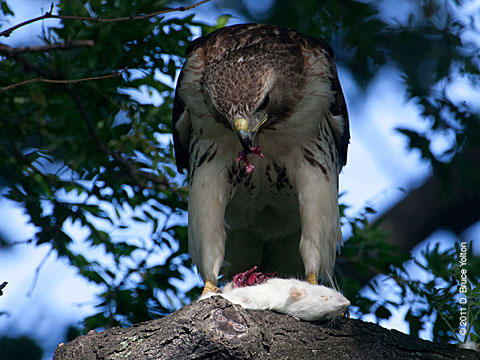The first eyass fledged on Wednesday according to veteran hawk watchers at Riverside Park. The other eyass also appears to have fledged on Thursday. Last year the parents, continued to feed the fledglings for a week on the nest, so the youngsters continued to sleep in the nest after they fledged. This year, this no rush attitude continues. Although both birds are reported to have fledged, one was hanging out in the nest on Friday.
While there is much joy over the fledging, there is still concern over the father’s poisoning by over application of poisons south of the Boat Basin earlier this year. Although there have been positive discussions, I don’t think we’ve cracked the bureaucracy of the Parks Department yet.
Balancing hawk safety and rat control is difficult but three major areas of concern have yet to be addressed by park administrators.
- Proper sanitation is the first priority in preventing rats. If you don’t feed them, you won’t have them. The dumpster at the Boat Basin is a breeding ground for rats. It is a large dumpster designed for yard waste and not garbage and is sitting in a pile of mud most days. The rats have a field day (or should we say field night) feasting on the garbage here. The dumpster has a gate opening at the back with a two inch gap. The rats just run in and out of the dumpster all night.
While everyone acknowledges the problem and the need to build a proper waste transfer area with a compactor, the Park administrators are claiming a lack of funds. There must be enough income from the café rent to siphon off a small portion to fix this deplorable situation. If not, why isn’t this a priority for the Riverside Park Fund? - The current Parks Department policy is to restrict poisoning during the period of time starting from when eggs hatch until the fledglings disperse in the late summer. I believe the experiences both at Riverside and in Astoria Park warrant a review of this policy and an extension of the restrictions to start a month earlier when the mother begins sitting on eggs. We’ve had too many poisoning of nesting parents in city parks recently.
- A commitment from Parks to evaluate and consider banning their practice of the underground baiting of rat borrows using second generation anticoagulant poisons. I believe this practice is contrary the recommendations of the EPA, who advises the poisons always be placed within 50 feet of buildings, and in bait stations, unless used against gophers or voles in agricultural settings, where it may be used underground.
Underground baiting allows rats to ingest extremely large doses of poisons before they get sick or die resulting extremely toxic rats.
There is no proof that using baiting stations properly deployed, which are much safer for non-targeted animals, children and pets, are any less effective than loose, underground applications of poisons.
Until we get a positive commitment from Parks to address theses three areas, I don’t think we should celebrate. If you are interested in writing, here are some key contacts:
John Herrold, Park Administrator, john.herrold@parks.nyc.gov
Robert Weigel, Chairman, Riverside Park Fund, rweigel@gibsondunn.com
William T. Castro, Manhattan Parks Commissioner, william.castro@parks.nyc.gov












